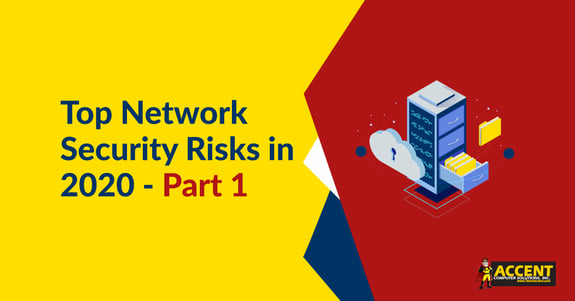If there's anything the last 20 years has shown us, it's that data security is paramount in modern business. Every year, the war rages on between hacker voraciousness and IT admin ingenuity. Every year, IT professionals invent new ways to stop hackers, and hackers find new weaknesses to exploit. In 2020, every business should be preparing for this year's wave of network security risks and the breaches of those brands who fall in the battle.
2019 was a tough year for network security. The number of incidents and the cost of a breach are both at an all-time high. The average cost of a data breach is 3.94 million dollars. More than 4.1 billion records were exposed in 2019, and it's been found that 84% of customers stop trusting a brand after a data breach. Data security is more important than ever before, and not just because regulations are on the rise.
To help you build your company's defenses, we're taking a deeper look into the top 10 network security risks to watch out for in 2020.
1. Mobile Devices
You can build your intranet like a fortress with an amazing firewall, encryption, and port control. You can harden each one of your internal end-points. But if you have a wifi network, mobile devices can and will bring outside programs into the network and potentially carry secure data off of your network.
Surprisingly enough, few companies have fully taken control of the network security risk created by wifi and mobile devices. Even company-provided devices that go home with employees can have outside apps installed and features enabled. The most basic phones and tablets (and now laptops) can take photos and make audio/video recordings and open connection to the internet can enable downloads and uploads onto your secure network.
Mobile devices are a wild card, but one that can be mitigated. Your company can support a mobile workforce and maintain internal data security with a careful and considerate mobile policy.
2. Adaptive Phishing
There is one type of network security risk that can never completely be stopped. No matter how innovative IT admins become and no matter how little the core tactics change, social engineering opens doors. There will always be a well-meaning employee who will open the wrong email or share information without verifying credentials first, no matter how many communication channels we secure or invent.
A long time ago, phishing started as phone scams. Then it evolved in the age of email into what we know as "classic" email phishing. Them we developed spam filters. Then there were forums and instant messenger (live chat) and phishing hackers adapted. Now the channels are expanding infinitely and the social-hackers are adapting.
Some call customer service lines or chat services. Some pretend to be friends on social media. Some are still using email with measured success. Be prepared and train your team to know the signs of phishing no matter what channel it comes through.
3. Transition and Transmission Exposure
Here in the tech security industry, we've gotten pretty good at securing our data repositories. Databases and servers can be protected in many different ways, with encryption as the finishing touch to render even stolen data useless, but what about when our data is in motion? Data is most likely to be exposed when it is being moved from one container to another, either because of the transition logistics or during the data transmission itself.
Data exposure during transition tends to come from small technical oversights. The new server might not be encrypted yet. Someone involved in the transition might gain access to secure data that they don't have clearance to see. Transitions always create an opportunity for data exposure that must be covered.
Transmission exposures occur when the data is traveling between secure points. Data can be read both wirelessly and through physical lines while it is traveling, which is why transmission encryption is so important.
4. Open-Source Oversight
If your business uses open-source software (OSS), you've got a potential network security risk. Open-source software is free and available to anyone, and many programs are updated by more than one team of developers. OSS has some distinct security downsides that can be managed, but only if you are aware of them.
First, open-source is available for anyone to crack into the source code. That means that hackers, too, can play in open source business software, finding all the weaknesses and practicing exploits.
Second, open-source often lacks in security updates where SaaS (Software as a Service) excels. It is often necessary to build and maintain your own security patches to close known gaps in security. This can help with the first problem as well.
Third, open-source software does not automatically update itself even when newer, more secure versions are available. Be sure to build a schedule for researching OSS updates and implementing those that are available.
5. In-Line or Supply-Chain Attacks
Hackers out for a pay-off over a big score have found a new favorite way to infiltrate: through your web store. Hackers like to slip their data collection malware in-between certain user interactions to steal things like login information, credit card numbers and credentials, and personal addresses. Sometimes they redirect your visitors to a spoof page or simply arrange to steal the information as it passes through your e-commerce platform.
This is traditionally called a supply-chain attack because the hacker gets in between your phases of sale. They do this by placing the malicious software in-line in the buyer journey.
Not only is it vital to constantly scan and audit for this kind of attack, but it can also lead to deeper infiltrations. If your POS system or computers are connected to the company network, then a supply-line attack can grow to infect the network for a more profound future infiltration.
6. IT Admin Burnout
Let's face it, the cyber security battle has been long and drawn out. Some IT admins have been doing this for two decades or even longer. Some of the young professionals coming into the industry are burning out before they get a chance to build their fortitude.
IT admins are responsible for dozens to thousands of individual checks, updates, and patches every year. Your IT team assists other employees with their security problems, secures all end-points and cloud locations for the entire business network, and must be ready at a minute's notice to enact defense and recovery procedures in the event of an attack.
So it's no wonder that admins are burning out at a faster rate than ever before. It's time for companies of all sizes to assess the risk and remedies for IT admin burnout to keep your team fresh, energized, and covering the many aspects of a secure business network.
Counter Burnout with Cyber Security Drills
One of the best ways to fight both IT admin burnout and complacency in your workforce is with cyber security drills. A variation of penetration testing, cyber security drills are spoof attacks that employees have a chance to identify and report. Your IT team can both run these spoofs and be subject to externally planned drills.
"Playing the bad guy" will keep your team both interested and thinking from a hacker perspective, while occasional internal drills will keep everyone on their toes. This kind of excitement can really help keep burnout at bay.
7. Deep Fake Infiltration
A deep fake is a fake person that seems real in every way that can be told remotely. They are expertly generated fake faces, voices, and even expressions and animated actions. They can take multiple "photos" of themselves in various poses and backgrounds. They have pretend personal profile information that might be consistent across multiple sites. They might even have a cadre of friends who are real people that believe the deep fake is real. But a deep fake is still a fake person. Except, of course when someone is running a deep fake of a real person using a digital rendering of them to make new images and media.
Deep fakes were once a novelty of the dark web and are now taking the internet by storm. Used for everything from jokes to infiltration, deep fakes can fool humans and security AIs alike and defenses against them are only now being developed. While the full risk to businesses is not yet realized, there have already been some serious impacts in the realm of social media campaigns and politics.
Deep fakes can be used to impersonate someone online, like a politician or a CEO. They can be used to empower a phishing expedition, and even to access online accounts.
8. Smart-Targeted and Malware Attacks
Malware was not always as intelligent as it is today. Malware that many IT admins started out with was clunky and indiscriminate. Worms infiltrated everything. Ransomware encrypted whole systems. Spamware filled your page with pop-ups. Or at least, that's how it used to be. Today, malware is much smarter and is often designed to target specific sensitive information inside infiltrated company networks.
Your business network security doesn't just need to stop malware, it needs to specifically protect your most at-risk data because that is what malware will target first. Even without a living hacker to direct a malware bug, it's now possible for malware from an employee's phone or an infected website to immediately begin infiltrating your network, seeking out the juiciest information a hacker can sell.
Smart-targeting is also being used with the latest wave of ransomware attacks. Modern ransomware permutations know how to target the information a business will pay the most dearly for. But don't be fooled. The best defense against ransomware is still to wipe and restore from backup. Your data may have already been stolen, or may never be recovered, because you can't trust hackers.
9. Insecure Test Environments
Test environments are an essential part of software and web development. You have to know how an update will impact the software and user experience by running it through a simulation of the original. This means creating a test environment that is an exact clone of the system you plan to update. Ideally, test environments are just as secure as the originals they are copies of, but this is not always the case.
Test environments are also best when they are lightweight and easy to spin up, shut down, or copy. This makes it tempting to keep them in a less secure and more accessible state, which is easier to run tests on and repeat the tests you run.
Unfortunately, this more accessible state may also become a network security risk, especially if your test environments are not secured behind their own firewall and encryption layers. Engineers who leave their test environments exposed are inviting hackers to take a waltz through the source code and possibly even to access the rest of the internal network through those test environment servers.
10. Cloud Security
2020 also brings new demands for cloud security. It used to be that network security was about securing your intranet. But with business integration with the cloud, your network is more complicated than that. Your local and remote servers need to communicate securely as a unified network without exposing your network outside of that controlled connection.
Cloud security includes transmission and transition security measures as well as the need to encrypt on every level. Each time you incorporate a cloud database or service, you need to reassess your security that keeps each step of data exchanges secure. Every company's cloud security solution will be different because tech stacks are so unique, and it's time to cover those bases.
11. AI and ML
Artificial Intelligence and Machine Learning have incredible potential, for both sides of the war. They both have incredible potential for search-and-destroy attacks and methodically unbeatable defenses. So it's no surprise that the engineers on both sides have begun developing an AI-driven arsenal. Hackers are building ML-supported defenses in order to practice breaking them. Cyber security engineers are mocking up AI malware to practice building defenses.
While we have yet to see the first wave of AI-breach news stories, AI and ML are already an important part of the future of the data security ware. Be prepared for both new defensive tools and new malware innovations that are self-learning and more devastatingly automated than ever before.
Are You Confident About Security?
Network security is one of the most important aspects of modern business management. Fighting back against hacker onslaughts is a constant battle, one that the entire business world has allied together to fight.
Contact us today for more network security insights or for the resources you need to boost your current security infrastructure.



.png)

